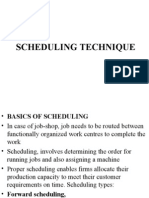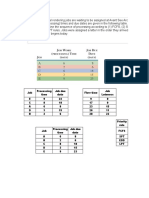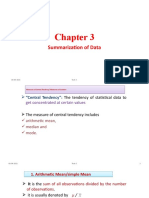08/01/2024
CHAPTER 2:
SINGLE MACHINE MODEL
Assoc. Prof. Dr. DO NGOC HIEN
Department of Industrial Systems Engineering (ISE )
Faculty of Mechanical Engineering (FME)
HoChiMinh City University of Technology (HCMUT)
1 Phone:
Email: hienise97@hcmut.edu.vn
1
� 08/01/2024
SINGLE MACHINE MODELS
SINGLE MACHINE MODELS
2
� 08/01/2024
WHERE CAN YOU RECOGNIZE THE
SINGLE MACHINE MODELS?
SEQUENCING JOBS
Specifies the order in which jobs should
be performed at work centers
Priority rules are used to dispatch or
sequence jobs
FCFS: First come, first served
SPT: Shortest processing time
EDD: Earliest due date
LPT: Longest processing time
3
� 08/01/2024
SEQUENCING EXAMPLE
Apply the four popular sequencing rules to
these five jobs
Job Work (Processing) Job Due
Time Date
Job (Days) (Days)
A 6 8
B 2 6
C 8 18
D 3 15
E 9 23
SEQUENCING EXAMPLE
FCFS: Sequence A-B-C-D-E
Job Work
Job (Processing) Flow Job Due Job
Sequence Time Time Date Lateness
A 6 6 8 0
B 2 8 6 2
C 8 16 18 0
D 3 19 15 4
E 9 28 23 5
28 77 11
4
� 08/01/2024
SEQUENCING EXAMPLE
FCFS: Sequence A-B-C-D-E
Sum of total flow time
Average completion time = Number of jobs
= 77/5 = 15.4 days
Total job work time
Utilization metric = Sum of total flow time = 28/77 = 36.4%
Average number of Sum of total flow time
jobs in the system = Total job work time = 77/28 = 2.75 jobs
Total late days
Average job lateness = Number of jobs = 11/5 = 2.2 days
SEQUENCING EXAMPLE
SPT: Sequence B-D-A-C-E
Job Work
Job (Processing) Flow Job Due Job
Sequence Time Time Date Lateness
B 2 2 6 0
D 3 5 15 0
A 6 11 8 3
C 8 19 18 1
E 9 28 23 5
28 65 9
5
� 08/01/2024
SEQUENCING EXAMPLE
SPT: Sequence B-D-A-C-E
Sum of total flow time
Average completion time = Number of jobs
= 65/5 = 13 days
Total job work time
Utilization metric = Sum of total flow time = 28/65 = 43.1%
Average number of Sum of total flow time
jobs in the system = Total job work time
= 65/28 = 2.32 jobs
Total late days
Average job lateness = Number of jobs = 9/5 = 1.8 days
SEQUENCING EXAMPLE
EDD: Sequence B-A-D-C-E
Job Work
Job (Processing) Flow Job Due Job
Sequence Time Time Date Lateness
B 2 2 6 0
A 6 8 8 0
D 3 11 15 0
C 8 19 18 1
E 9 28 23 5
28 68 6
6
� 08/01/2024
SEQUENCING EXAMPLE
EDD: Sequence B-A-D-C-E
Sum of total flow time
Average completion time = Number of jobs
= 68/5 = 13.6 days
Total job work time
Utilization metric = Sum of total flow time = 28/68 = 41.2%
Average number of Sum of total flow time
jobs in the system = Total job work time
= 68/28 = 2.43 jobs
Total late days
Average job lateness = Number of jobs = 6/5 = 1.2 days
SEQUENCING EXAMPLE
LPT: Sequence E-C-A-D-B
Job Work
Job (Processing) Flow Job Due Job
Sequence Time Time Date Lateness
E 9 9 23 0
C 8 17 18 0
A 6 23 8 15
D 3 26 15 11
B 2 28 6 22
28 103 48
7
� 08/01/2024
SEQUENCING EXAMPLE
LPT: Sequence E-C-A-D-B
Sum of total flow time
Average completion time = Number of jobs
= 103/5 = 20.6 days
Total job work time
Utilization metric = Sum of total flow time = 28/103 = 27.2%
Average number of Sum of total flow time
jobs in the system = Total job work time
= 103/28 = 3.68 jobs
Total late days
Average job lateness = Number of jobs = 48/5 = 9.6 days
SEQUENCING EXAMPLE
Summary of Rules
Average
Average Number of Average
Completion Utilization Jobs in Lateness
Rule Time (Days) Metric (%) System (Days)
FCFS 15.4 36.4 2.75 2.2
SPT 13.0 43.1 2.32 1.8
EDD 13.6 41.2 2.43 1.2
LPT 20.6 27.2 3.68 9.6
8
� 08/01/2024
COMPARISON OF
SEQUENCING RULES
No one sequencing rule excels on all criteria
1. SPT does well on minimizing flow time and
number of jobs in the system
► But SPT moves long jobs to
the end which may result
in dissatisfied customers
2. FCFS does not do especially
well (or poorly) on any
criteria but is perceived
as fair by customers
3. EDD minimizes maximum
lateness
SEQUENCING Apply the four popular sequencing rules (FCFS,
SPT, EDD, LPT) to these five jobs
AIC! 15 MINUTES >>Calculate the Objective values and filling them
in the second Table
Job Work (Processing) Time Job Due Date
Job (Days) (Days)
A 10 18
B 5 9
C 8 20
D 4 15
E 9 25
Average
Average Number of Average
Completion Utilization Jobs in Lateness
Rule Time (Days) Metric (%) System (Days)
FCFS
SPT
EDD
LPT
9
� 08/01/2024
CRITICAL RATIO (CR)
An index number found by dividing the time
remaining until the due date by the work time
remaining on the job
Jobs with low critical ratios are scheduled
ahead of jobs with higher critical ratios
Performs well on average job lateness criteria
CRITICAL RATIO EXAMPLE
Currently Day 25
JOB DUE DATE WORKDAYS REMAINING
A 30 4
B 28 5
C 27 2
JOB CRITICAL RATIO PRIORITY ORDER
A (30 - 25)/4 = 1.25 3
B (28 - 25)/5 = .60 1
C (27 - 25)/2 = 1.00 2
With CR < 1, Job B is late. Job C is just on schedule and
Job A has some slack time.
10
� 08/01/2024
CRITICAL RATIO TECHNIQUE
1. Helps determine the status of specific
jobs
2. Establishes relative priorities among
jobs on a common basis
3. Adjusts priorities automatically for
changes in both demand and job
progress
4. Dynamically tracks job progress
22
11
� 08/01/2024
23
24
12
� 08/01/2024
AIC! 10 MINUTES
Job pj
1 7
2 9
3 11
4 8
5 2
6 6
Determine the optimum sequence of the jobs!
25
Calculate the objective value!
26
13
� 08/01/2024
AIC! 5 MINUTES
27
28
14
� 08/01/2024
29
WSPT (SMITH RULE)
Note: Various optimizers for single – stage production
30
15
� 08/01/2024
WSPT (SMITH RULE)
31
AIC! 10 MINUTES
WSPT:
Job Pj Wj
A 5 3
B 4 1
C 3 2
D 6 2
E 8 3
F 4 5
Determine the sequence of the jobs with WSPT rule!
Calculate the Objective value! 32
16
� 08/01/2024
TOTAL WEIGHTED COMPLETION TIME
33
TOTAL WEIGHTED COMPLETION TIME WITH
CHAINS
34
17
� 08/01/2024
EXAMPLE: TOTAL WEIGHTED COMPLETION
TIME WITH CHAINS
35
36
18
� 08/01/2024
AIC! 10 MINUTES
TOTAL W EIGHTED COMPLETION TIME WITH CHAINS
WSPT:
Job pj wj
A 5 3
B 4 1
C 3 2
D 6 2
E 8 3
F 4 5
With two chains: A>>B>>C & D>>E>>F
Determine the sequence of the jobs! 37
Calculate the Objective value!
PREEMTION
38
19
� 08/01/2024
PREEMTION
39
PREEMTION
40
20
� 08/01/2024
SRPT-RULE FOR PROBLEM
41
SRPT-RULE FOR PROBLEM
42
21
� 08/01/2024
SRPT-RULE FOR PROBLEM
43
SRPT-RULE FOR PROBLEM
44
22
� 08/01/2024
SRPT-RULE FOR PROBLEM
45
SRPT-RULE FOR PROBLEM
46
23
� 08/01/2024
SRPT-RULE FOR PROBLEM
47
SRPT-RULE FOR PROBLEM
48
24
� 08/01/2024
SRPT-RULE FOR PROBLEM
49
SRPT-RULE FOR PROBLEM
50
25
� 08/01/2024
SRPT-RULE FOR PROBLEM
51
SRPT-RULE FOR PROBLEM
52
26
� 08/01/2024
SRPT-RULE FOR PROBLEM
53
SRPT-RULE FOR PROBLEM
54
27
� 08/01/2024
SRPT-RULE FOR PROBLEM
55
SRPT-RULE FOR PROBLEM
56
28
� 08/01/2024
SRPT-RULE FOR PROBLEM
AIC! 15 MINUTES
Job rj pj Determine the optimum
A 2 4 sequence of the jobs!
B 0 6
C 7 3
Calculate the objective value!
D 16 7
E 0 9
F 21 2
G 7 5
H 25 3
57
DUE DATE SCHEDULING
58
29
� 08/01/2024
MAXIMUM LATENESS
59
AIC! 10 MINUTES
MAXIMUM LATENESS
Determine the optimum
sequence of the jobs!
Calculate the Objective
value!
60
30
� 08/01/2024
THE NUMBER OF TARDY JOBS:
MOORE RULE
61
THE NUMBER OF TARDY JOBS:
MOORE RULE
62
31
� 08/01/2024
THE NUMBER OF TARDY JOBS:
MOORE RULE
63
THE NUMBER OF TARDY JOBS:
MOORE RULE
64
32
� 08/01/2024
THE NUMBER OF TARDY JOBS: MOORE RULE
AIC! 10 MINUTES
Job pj dj
1 5 9
2 9 16
3 11 25
4 4 14
5 2 8
6 6 17
Determine the sequence of the jobs using the Moore rule!
Calculate the objective value! 65
a) 5 - 1 - 4 - 6 - 3 - [2] late
b) obj value = 1
NUMBER OF TARDY JOBS:
66
33
� 08/01/2024
NUMBER OF TARDY JOBS
ALGORITHM FOR SOLVING
67
NUMBER OF TARDY JOBS
EXAMPLE
68
34
� 08/01/2024
NUMBER OF TARDY JOBS
AIC! 05 MINUTES
Jobs 1 2 3 4 5 6
pj 6 8 9 5 11 3
dj 10 16 14 20 19 13
Determine the optimum solution (sequence of the jobs)!
Find out the objective value!
69
MAXIMUM LATENESS
70
35
� 08/01/2024
BRANCH AND BOUND
A method of effective
enumeration
Generate a node tree
Compute the objective of a
feasible schedule (feasible
node)
Compute lower bounds for
a class of schedules (node)
The node can be eliminated
if the lower bound is higher
than the cost of a schedule
obtained earlier 71
BRANCH AND BOUND FOR
1 | RJ | LMAX
Branching
Level 0: single node and no jobs have
been scheduled
Level 1: n nodes such that job j is
scheduled first at node j
Level k: jobs in the first k positions have
been specified
72
36
� 08/01/2024
BRANCH AND BOUND FOR
1 | RJ | LMAX
Branching
At a node let J be the set of jobs that have
not been scheduled
Also let t be the time when a job can start
processing at the node
Only create a node for job j at the node if
rj < minlJ (max(t,rl) + pl)
73
BRANCH AND BOUND FOR
1 | RJ | LMAX
Bounding
At each node compute the optimal value
using 1 | rj , prmp | Lmax for the remaining
jobs
Preemptive EDD rule is optimal for
1 | rj , prmp | Lmax
If the preemptive solution gives a non-
preemptive schedule then it is feasible
74
37
� 08/01/2024
OPTIMAL SOLUTION FOR 1 | RJ | LMAX
EXAMPLE
Usebranch and bound to determine the
schedule for 1 | rj | Lmax and compute the
optimal value for
job j 1 2 3 4
pj 4 2 6 5
rj 0 1 3 5
dj 8 12 11 10
75
OPTIMAL SOLUTION FOR 1 | RJ | LMAX
EXAMPLE
76
38
� 08/01/2024
OPTIMAL SOLUTION FOR 1 | RJ | LMAX
EXAMPLE
77
OPTIMAL SOLUTION FOR 1 | RJ | LMAX
AIC! 10 MINUTES
Usebranch and bound to determine the
schedule for 1 | rj | Lmax and compute the
optimal value for
job j 1 2 3 4
pj 6 2 6 5
rj 0 7 2 5
dj 15 12 9 10
78
39
� 08/01/2024
79
80
40
� 08/01/2024
81
82
41
� 08/01/2024
83
84
42
� 08/01/2024
85
86
43
� 08/01/2024
87
88
44
� 08/01/2024
89
45
























































































